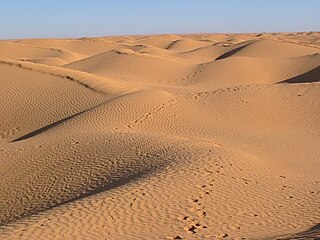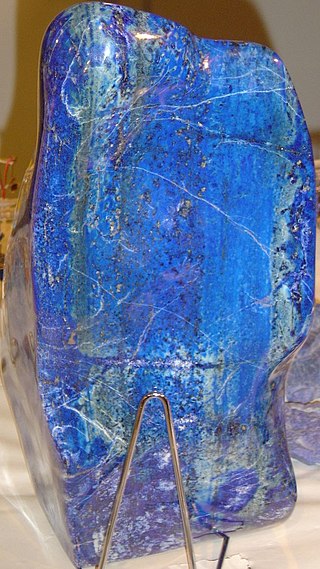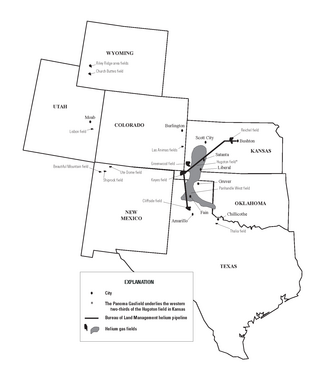
Sonatrach is the national state-owned oil company of Algeria. Founded in 1963, it is known today to be the largest company in Africa with 154 subsidiaries, and often referred as the first African oil "major". In 2021, Sonatrach was the seventh largest gas company in the world.

Hassi R'Mel is a town in Algeria located near the 18th largest gas field worldwide. Hassi R'Mel is located in Laghouat Province 60 kilometres (37 mi) northwest of Ghardaïa. It is the capital of Hassi R'Mel District. Hassi R'Mel has an airport.

Hassi Messaoud is a town in Ouargla Province, eastern Algeria, located 85 kilometres (53 mi) southeast of Ouargla. As of 2008 it had a population of 45,147 people, up from 40,360 in 1998, and an annual population growth rate of 1.1%, the lowest in the province. Oil was discovered there in 1956 and the town's prominence has grown rapidly since then; it is considered as the First Energy town in Algeria where all the big oil and gas companies have offices and bases. It is an oil refinery town named after the first oil well. A water well, dug in 1917, can be found on the airport side of town. Today there are over 800 wells within a 25 kilometres (16 mi) radius of the town.

In Amenas is a town and commune in eastern Algeria, bordering with Libya. The town is located 30 kilometres (19 mi) west of the border. There is no border crossing in the area. The municipality had 7,385 inhabitants in 2008, up from 5.302 in 1998, with an annual growth rate of 3.4% According to the Algerian novelist Mouloud Mammeri the name is a Tuareg word which means "place of camel drivers."

The Grand Erg Oriental is a large erg or "field of sand dunes" in the Sahara Desert. Situated for the most part in Saharan lowlands of northeast Algeria, the Grand Erg Oriental covers an area some 600 km wide by 200 km north to south. The erg's northeastern edge spills over into neighbouring Tunisia.

Mining in Afghanistan was controlled by the Ministry of Mines and Petroleum, prior to the August 15th takeover by the Taliban. It is headquartered in Kabul with regional offices in other parts of the country. Afghanistan has over 1,400 mineral fields, containing barite, chromite, coal, copper, gold, iron ore, lead, natural gas, petroleum, precious and semi-precious stones, salt, sulfur, lithium, talc, and zinc, among many other minerals. Gemstones include high-quality emeralds, lapis lazuli, red garnet and ruby. According to a joint study by The Pentagon and the United States Geological Survey, Afghanistan has an estimated US$1 trillion of untapped minerals.
As of 2005, Azerbaijan produced a range of metals and industrial minerals, including aluminum, lead, iron, and zinc.
The mineral industry of Kazakhstan is one of the most competitive and fastest growing sectors of the country. Kazakhstan ranks second to Russia among the countries of the CIS in its quantity of mineral production. It is endowed with large reserves of a wide range of metallic ores, industrial minerals, and fuels, and its metallurgical sector is a major producer of a large number of metals from domestic and imported raw materials. In 2005, its metal mining sector produced bauxite, chromite, copper, iron, lead, manganese, and zinc ores, and its metallurgical sector produced such metals as beryllium, bismuth, cadmium, copper, ferroalloys, lead, magnesium, rhenium, steel, titanium, and zinc. The country produced significant amounts of other nonferrous and industrial mineral products, such as alumina, arsenic, barite, gold, molybdenum, phosphate rock, and tungsten. The country was a large producer of mineral fuels, including coal, natural gas, oil, and uranium. The country's economy is heavily dependent on the production of minerals. Output from Kazakhstan's mineral and natural resources sector for 2004 accounted for 74.1% of the value of industrial production, of which 43.1% came from the oil and gas condensate extraction. In 2004, the mineral extraction sector accounted for 32% of the GDP, employed 191,000 employees, and accounted for 33.1% of capital investment and 64.5% of direct foreign investment, of which 63.5% was in the oil sector. Kazakhstan's mining industry is estimated at US$29.5 billion by 2017.
The second-largest mineral industry in the world is the mineral industry of Africa, which implies large quantities of resources due to Africa being the second largest continent, with 30.37 million square kilometres of land.With a population of 1.4 billion living there, mineral exploration and production constitute significant parts of their economies for many African countries and remain keys to economic growth. Africa is richly endowed with mineral reserves and ranks first in quantity of world reserves for bauxite, cobalt, industrial diamond, phosphate rock, platinum-group metals (PGM), vermiculite, and zirconium.

Mining is the biggest contributor to Namibia's economy in terms of revenue. It accounts for 25% of the country's income. Its contribution to the gross domestic product is also very important and makes it one of the largest economic sectors of the country. Namibia produces diamonds, uranium, copper, magnesium, zinc, silver, gold, lead, semi-precious stones and industrial minerals. The majority of revenue comes from diamond mining. In 2014, Namibia was the fourth-largest exporter of non-fuel minerals in Africa.
The Hassi R'Mel Gas Field is the largest gas field in Algeria and one of the largest gas fields in the world. It is located in the vicinity of Hassi R'Mel village, 550 kilometres (340 mi) south of Algiers. The gas field extends 70 kilometres (43 mi) from north to south and 50 kilometres (31 mi) from east to west.

Algeria's economy continued to recover in the first half of 2022, led by a return of oil production to pre-pandemic levels and a continued recovery of the service sector along with a more vigorous agricultural activity. The recovery should continue into 2023, supported by the nonhydrocarbon sector and public expenditure growth, according to the latest edition of the World Bank's Algeria Economic Update.

The mineral industry of Peru has played an important role in that nation's history and been integral to the country's economic growth for several decades. The industry has also contributed to environmental degradation and environmental injustice; and is a source of environmental conflicts that shape public debate on good governance and development.
Mauritania's mineral sector was dominated by iron ore mining and beneficiation. Other mineral commodities produced in the country included cement, copper, gold, gypsum, petroleum, salt, and steel. The Ministère des Mines et de l’Industrie was the Government agency responsible for enacting the Mining Code and for the coordination of all activities in the mining sector. The Direction des Mines et de la Géologie was the entity responsible for promoting the mineral sector and for providing geologic and mining information to potential investors; the Direction des Hydrocarbures was in charge of the development of the petroleum sector; and the Office Mauritanien des Recherches Géologiques was the Government entity responsible for evaluating areas of mineral potential for exploration. Société Nationale Industrielle et Minière (SNIM) was responsible for iron ore production and benefciation.

Energy in Algeria describes energy and electricity production, consumption and import in Algeria. Primary energy use in 2009 in Algeria was 462 TWh and 13 TWh per million persons. Algeria is an OPEC country.
The natural resources of the Arctic are the mineral and animal natural resources which provide or have potential to provide utility or economic benefit to humans. The Arctic contains significant amounts of minerals, boreal forests, marine life, and fresh water.

The mining industry of Tunisia focuses mainly on phosphate products such as fertilizer, industrial minerals, iron ore, and salt. Mine ownership is limited to the Government of Tunisia, although operation by private entities is encouraged.

Helium production in the United States totaled 73 million cubic meters in 2014. The US was the world's largest helium producer, providing 40 percent of world supply. In addition, the US federal government sold 30 million cubic meters from storage. Other major helium producers were Algeria and Qatar.
This article covers the history of the nationalization of oil in Algeria.

The Arzew Gas Terminal is a large and historically important gas terminal on the coast of Algeria.













